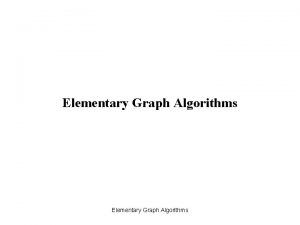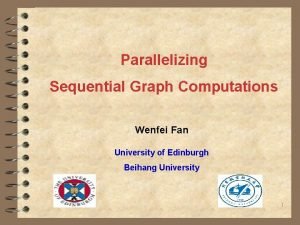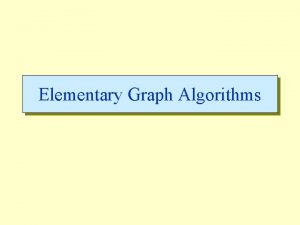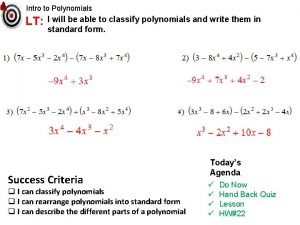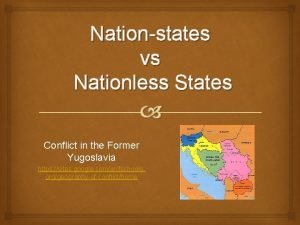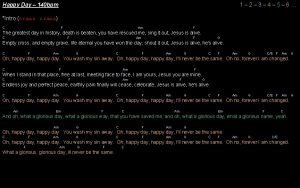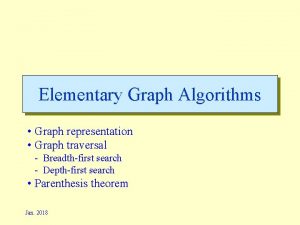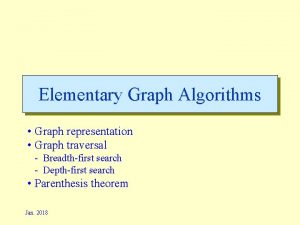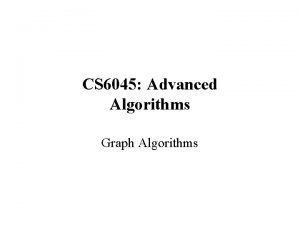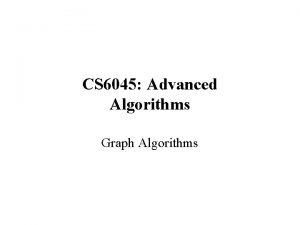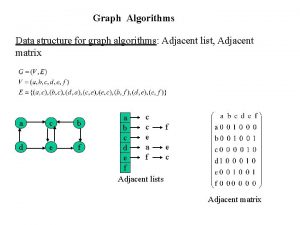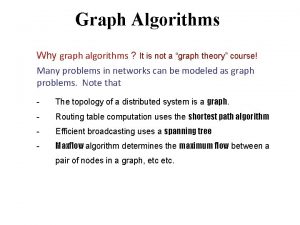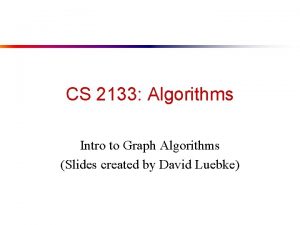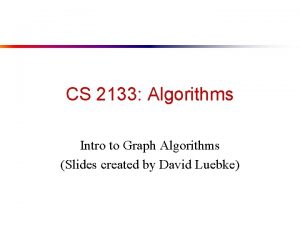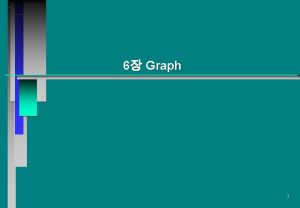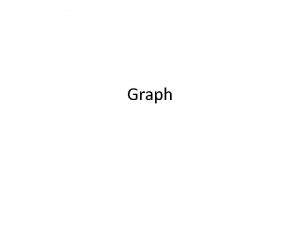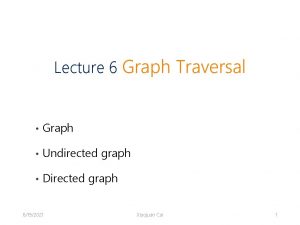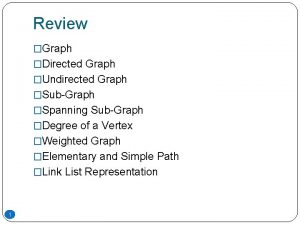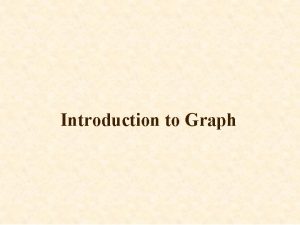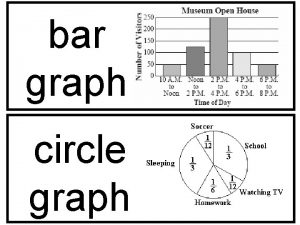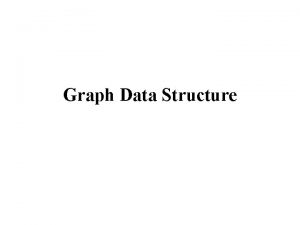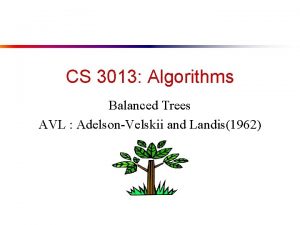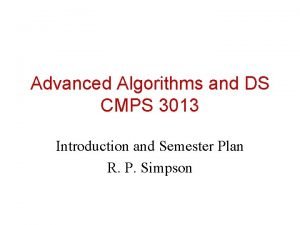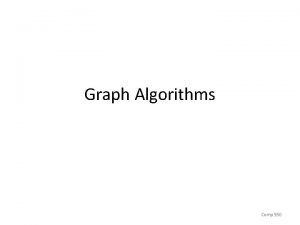CS 3013 DS Algorithms Intro to Graph Algorithms









































































- Slides: 73

CS 3013: DS & Algorithms Intro to Graph Algorithms

Graphs l A graph G = (V, E) n n n V = set of vertices E = set of edges = subset of V V Thus |E| = O(|V|2)

Graph Variations l Variations: n n A connected graph has a path from every vertex to every other In an undirected graph: u Edge (u, v) = edge (v, u) u No self-loops n In a directed graph: u Edge (u, v) goes from vertex u to vertex v, notated u v

Graph Variations l More variations: n A weighted graph associates weights with either the edges or the vertices u E. g. , n a road map: edges might be weighted w/ distance A multigraph allows multiple edges between the same vertices u E. g. , the call graph in a program (a function can get called from multiple other functions)

Graphs l We will typically express running times in terms of |E| and |V| (often dropping the |’s) n n l If |E| |V|2 the graph is dense If |E| |V| the graph is sparse If you know you are dealing with dense or sparse graphs, different data structures may make sense

Representing Graphs Assume V = {1, 2, …, n} l An adjacency matrix represents the graph as a n x n matrix A: l n A[i, j] = 1 if edge (i, j) E (or weight of edge) = 0 if edge (i, j) E

Graphs: Adjacency Matrix l Example: A 1 d b 4 c 3 2 3 1 a 2 1 2 3 4 ? ? 4

Graphs: Adjacency Matrix l Example: 1 a d 2 b 4 c 3 A 1 2 3 4 1 0 1 1 0 2 0 0 1 0 3 0 0 4 0 0 1 0

Graphs: Adjacency Matrix How much storage does the adjacency matrix require? l A: O(V 2) l What is the minimum amount of storage needed by an adjacency matrix representation of an undirected graph with 4 vertices? l A: 6 bits l n n Undirected graph matrix is symmetric No self-loops don’t need diagonal

Graphs: Adjacency Matrix l The adjacency matrix is a dense representation n n l Usually too much storage for large graphs But can be very efficient for small graphs Most large interesting graphs are sparse n n E. g. , planar graphs, in which no edges cross, have |E| = O(|V|) by Euler’s formula For this reason the adjacency list is often a more appropriate respresentation

Graphs: Adjacency List Adjacency list: for each vertex v V, store a list of vertices adjacent to v l Example: 1 l n n l Adj[1] = {2, 3} Adj[2] = {3} Adj[3] = {} Adj[4] = {3} 2 Variation: can also keep a list of edges coming into vertex 4 3

Graphs: Adjacency List l How much storage is required? n The degree of a vertex v = # incident edges u Directed n n l graphs have in-degree, out-degree For directed graphs, # of items in adjacency lists is out-degree(v) = |E| takes (V + E) storage (Why? ) For undirected graphs, # items in adj lists is degree(v) = 2 |E| (handshaking lemma) also (V + E) storage So: Adjacency lists take O(V+E) storage

Graph Searching Given: a graph G = (V, E), directed or undirected l Goal: methodically explore every vertex and every edge l Ultimately: build a tree on the graph l n n n Pick a vertex as the root Choose certain edges to produce a tree Note: might also build a forest if graph is not connected

Breadth-First Search l “Explore” a graph, turning it into a tree n n l One vertex at a time Expand frontier of explored vertices across the breadth of the frontier Builds a tree over the graph n n Pick a source vertex to be the root Find (“discover”) its children, then their children, etc.

Breadth-First Search l Again will associate vertex “colors” to guide the algorithm n White vertices have not been discovered u n Grey vertices are discovered but not fully explored u n They may be adjacent to white vertices Black vertices are discovered and fully explored u l All vertices start out white They are adjacent only to black and gray vertices Explore vertices by scanning adjacency list of grey vertices

Breadth-First Search BFS(G, s) { initialize vertices; Q = {s}; // Q is a queue (duh); initialize to s while (Q not empty) { u = Remove. Top(Q); for each v u->adj { if (v->color == WHITE) v->color = GREY; v->d = u->d + 1; What does v->d represent? v->p = u; Enqueue(Q, v); What does v->p represent? } u->color = BLACK; } }

Breadth-First Search: Example r s t u v w x y

Breadth-First Search: Example r s t u 0 v w x y Q: s

Breadth-First Search: Example r s t u 1 0 1 v w x y Q: w r

Breadth-First Search: Example r s t u 1 0 2 1 2 v w x y Q: r t x

Breadth-First Search: Example r s t u 1 0 2 2 1 2 v w x y Q: t x v

Breadth-First Search: Example r s t u 1 0 2 3 2 1 2 v w x y Q: x v u

Breadth-First Search: Example r s t u 1 0 2 3 2 1 2 3 v w x y Q: v u y

Breadth-First Search: Example r s t u 1 0 2 3 2 1 2 3 v w x y Q: u y

Breadth-First Search: Example r s t u 1 0 2 3 2 1 2 3 v w x y Q: y

Breadth-First Search: Example r s t u 1 0 2 3 2 1 2 3 v w x y Q: Ø

BFS: The Code Again BFS(G, s) { initialize vertices; Touch every vertex: O(V) Q = {s}; while (Q not empty) { u = Remove. Top(Q); for each v u->adj { u = every vertex, but only once (Why? ) if (v->color == WHITE) v->color = GREY; So v = every vertex v->d = u->d + 1; that appears in v->p = u; some other vert’s Enqueue(Q, v); } adjacency list u->color = BLACK; What will be the running time? } } Total running time: O(V+E)

BFS: The Code Again BFS(G, s) { initialize vertices; Q = {s}; while (Q not empty) { u = Remove. Top(Q); for each v u->adj { if (v->color == WHITE) v->color = GREY; v->d = u->d + 1; v->p = u; Enqueue(Q, v); } What will be the storage cost u->color = BLACK; in addition to storing the tree? } } Total space used: O(max(degree(v))) = O(E)

Breadth-First Search: Properties l BFS calculates the shortest-path distance to the source node n n l Shortest-path distance (s, v) = minimum number of edges from s to v, or if v not reachable from s Proof given in the book (p. 472 -5) BFS builds breadth-first tree, in which paths to root represent shortest paths in G n Thus can use BFS to calculate shortest path from one vertex to another in O(V+E) time

Depth-First Search l Depth-first search is another strategy for exploring a graph n n n Explore “deeper” in the graph whenever possible Edges are explored out of the most recently discovered vertex v that still has unexplored edges When all of v’s edges have been explored, backtrack to the vertex from which v was discovered

Depth-First Search Vertices initially colored white l Then colored gray when discovered l Then black when finished l

Depth-First Search: The Code DFS(G) { for each vertex u G->V { u->color = WHITE; } time = 0; for each vertex u G->V { if (u->color == WHITE) DFS_Visit(u); } } DFS_Visit(u) { u->color = GREY; time = time+1; u->d = time; for each v u->Adj[] { if (v->color == WHITE) DFS_Visit(v); } u->color = BLACK; time = time+1; u->f = time; }

Depth-First Search: The Code DFS(G) { for each vertex u G->V { u->color = WHITE; } time = 0; for each vertex u G->V { if (u->color == WHITE) DFS_Visit(u); } } DFS_Visit(u) { u->color = GREY; time = time+1; u->d = time; for each v u->Adj[] { if (v->color == WHITE) DFS_Visit(v); } u->color = BLACK; time = time+1; u->f = time; } What does u->d represent?

Depth-First Search: The Code DFS(G) { for each vertex u G->V { u->color = WHITE; } time = 0; for each vertex u G->V { if (u->color == WHITE) DFS_Visit(u); } } DFS_Visit(u) { u->color = GREY; time = time+1; u->d = time; for each v u->Adj[] { if (v->color == WHITE) DFS_Visit(v); } u->color = BLACK; time = time+1; u->f = time; } What does u->f represent?

Depth-First Search: The Code DFS(G) { for each vertex u G->V { u->color = WHITE; } time = 0; for each vertex u G->V { if (u->color == WHITE) DFS_Visit(u); } } DFS_Visit(u) { u->color = GREY; time = time+1; u->d = time; for each v u->Adj[] { if (v->color == WHITE) DFS_Visit(v); } u->color = BLACK; time = time+1; u->f = time; } Will all vertices eventually be colored black?

Depth-First Search: The Code DFS(G) { for each vertex u G->V { u->color = WHITE; } time = 0; for each vertex u G->V { if (u->color == WHITE) DFS_Visit(u); } } DFS_Visit(u) { u->color = GREY; time = time+1; u->d = time; for each v u->Adj[] { if (v->color == WHITE) DFS_Visit(v); } u->color = BLACK; time = time+1; u->f = time; } What will be the running time?

Depth-First Search: The Code DFS(G) { for each vertex u G->V { u->color = WHITE; } time = 0; for each vertex u G->V { if (u->color == WHITE) DFS_Visit(u); } } DFS_Visit(u) { u->color = GREY; time = time+1; u->d = time; for each v u->Adj[] { if (v->color == WHITE) DFS_Visit(v); } u->color = BLACK; time = time+1; u->f = time; } Running time: O(n 2) because call DFS_Visit on each vertex, and the loop over Adj[] can run as many as |V| times

Depth-First Search: The Code DFS(G) { for each vertex u G->V { u->color = WHITE; } time = 0; for each vertex u G->V { if (u->color == WHITE) DFS_Visit(u); } } DFS_Visit(u) { u->color = GREY; time = time+1; u->d = time; for each v u->Adj[] { if (v->color == WHITE) DFS_Visit(v); } u->color = BLACK; time = time+1; u->f = time; } BUT, there is actually a tighter bound. How many times will DFS_Visit() actually be called?

Depth-First Search: The Code DFS(G) { for each vertex u G->V { u->color = WHITE; } time = 0; for each vertex u G->V { if (u->color == WHITE) DFS_Visit(u); } } DFS_Visit(u) { u->color = GREY; time = time+1; u->d = time; for each v u->Adj[] { if (v->color == WHITE) DFS_Visit(v); } u->color = BLACK; time = time+1; u->f = time; } So, running time of DFS = O(V+E)

Depth-First Sort Analysis l This running time argument is an informal example of amortized analysis n “Charge” the exploration of edge to the edge: u Each loop in DFS_Visit can be attributed to an edge in the graph u Runs once/edge if directed graph, twice if undirected u Thus loop will run in O(E) time, algorithm O(V+E) ] n Considered linear for graph, b/c adj list requires O(V+E) storage Important to be comfortable with this kind of reasoning and analysis

DFS Example source vertex

DFS Example source vertex d f 1 | | | |

DFS Example source vertex d f 1 | | 2 | | |

DFS Example source vertex d 1 | f | 2 | | | 3 | | |

DFS Example source vertex d f 1 | | 2 | | | 3 | 4 | |

DFS Example source vertex d f 1 | | 2 | | | 3 | 4 5 | |

DFS Example source vertex d f 1 | | 2 | | | 3 | 4 5 | 6 |

DFS Example source vertex d f 1 | 8 | 2 | 7 | | 3 | 4 5 | 6 |

DFS Example source vertex d f 1 | 8 | 2 | 7 | | 3 | 4 5 | 6 |

DFS Example source vertex d f 1 | 8 | 2 | 7 | 9 | 3 | 4 5 | 6 What is the structure of the grey vertices? What do they represent? |

DFS Example source vertex d f 1 | 8 | 2 | 7 | 9 |10 3 | 4 5 | 6 |

DFS Example source vertex d f 1 | 8 |11 2 | 7 | 9 |10 3 | 4 5 | 6 |

DFS Example source vertex d f 1 |12 8 |11 2 | 7 | 9 |10 3 | 4 5 | 6 |

DFS Example source vertex d f 1 |12 8 |11 2 | 7 13| 9 |10 3 | 4 5 | 6 |

DFS Example source vertex d f 1 |12 8 |11 2 | 7 13| 9 |10 3 | 4 5 | 6 14|

DFS Example source vertex d f 1 |12 8 |11 2 | 7 13| 9 |10 3 | 4 5 | 6 14|15

DFS Example source vertex d f 1 |12 8 |11 2 | 7 13|16 9 |10 3 | 4 5 | 6 14|15

DFS: Kinds of edges l DFS introduces an important distinction among edges in the original graph: n Tree edge: encounter new (white) vertex u The tree edges form a spanning forest u Can tree edges form cycles? Why or why not?

DFS Example source vertex d f 1 |12 8 |11 2 | 7 13|16 9 |10 3 | 4 Tree edges 5 | 6 14|15

DFS: Kinds of edges l DFS introduces an important distinction among edges in the original graph: n n Tree edge: encounter new (white) vertex Back edge: from descendent to ancestor u Encounter a grey vertex (grey to grey)

DFS Example source vertex d f 1 |12 8 |11 2 | 7 13|16 9 |10 3 | 4 Tree edges Back edges 5 | 6 14|15

DFS: Kinds of edges l DFS introduces an important distinction among edges in the original graph: n n n Tree edge: encounter new (white) vertex Back edge: from descendent to ancestor Forward edge: from ancestor to descendent u Not a tree edge, though u From grey node to black node

DFS Example source vertex d f 1 |12 8 |11 2 | 7 13|16 9 |10 3 | 4 5 | 6 Tree edges Back edges Forward edges 14|15

DFS: Kinds of edges l DFS introduces an important distinction among edges in the original graph: n n Tree edge: encounter new (white) vertex Back edge: from descendent to ancestor Forward edge: from ancestor to descendent Cross edge: between a tree or subtrees u From a grey node to a black node

DFS Example source vertex d f 1 |12 8 |11 2 | 7 13|16 9 |10 3 | 4 5 | 6 14|15 Tree edges Back edges Forward edges Cross edges

DFS: Kinds of edges l DFS introduces an important distinction among edges in the original graph: n n l Tree edge: encounter new (white) vertex Back edge: from descendent to ancestor Forward edge: from ancestor to descendent Cross edge: between a tree or subtrees Note: tree & back edges are important; most algorithms don’t distinguish forward & cross

DFS: Kinds Of Edges Thm 23. 9: If G is undirected, a DFS produces only tree and back edges l Proof by contradiction: source l n Assume there’s a forward edge u But F? edge must actually be a back edge (why? ) F?

DFS: Kinds Of Edges l l Thm 23. 9: If G is undirected, a DFS produces only tree and back edges Proof by contradiction: n Assume there’s a cross edge source But C? edge cannot be cross: u must be explored from one of the vertices it connects, becoming a tree vertex, before other vertex is explored u So in fact the picture is wrong…both lower tree edges cannot in fact be tree edges u C?

DFS And Graph Cycles l Thm: An undirected graph is acyclic iff a DFS yields no back edges n n If acyclic, no back edges (because a back edge implies a cycle If no back edges, acyclic No back edges implies only tree edges (Why? ) u Only tree edges implies we have a tree or a forest u Which by definition is acyclic u l Thus, can run DFS to find whether a graph has a cycle

DFS And Cycles l How would you modify the code to detect cycles? DFS(G) { for each vertex u G->V { u->color = WHITE; } time = 0; for each vertex u G->V { if (u->color == WHITE) DFS_Visit(u); } } DFS_Visit(u) { u->color = GREY; time = time+1; u->d = time; for each v u->Adj[] { if (v->color == WHITE) DFS_Visit(v); } u->color = BLACK; time = time+1; u->f = time; }

DFS And Cycles l What will be the running time? DFS(G) { for each vertex u G->V { u->color = WHITE; } time = 0; for each vertex u G->V { if (u->color == WHITE) DFS_Visit(u); } } DFS_Visit(u) { u->color = GREY; time = time+1; u->d = time; for each v u->Adj[] { if (v->color == WHITE) DFS_Visit(v); } u->color = BLACK; time = time+1; u->f = time; }

DFS And Cycles What will be the running time? l A: O(V+E) l We can actually determine if cycles exist in O(V) time: l n n In an undirected acyclic forest, |E| |V| - 1 So count the edges: if ever see |V| distinct edges, must have seen a back edge along the way

The End
 Rubrik pemarkahan
Rubrik pemarkahan Cs 3013
Cs 3013 Cs 3013
Cs 3013 Undirected graph algorithms
Undirected graph algorithms Elementary graph
Elementary graph When graphs are life
When graphs are life W graph
W graph Line graph graph theory
Line graph graph theory Wait-for graph
Wait-for graph Intro to the odyssey
Intro to the odyssey Intro to polynomials
Intro to polynomials Intro to malware
Intro to malware Intro.php?aid=
Intro.php?aid= Orphan graphic design
Orphan graphic design A-192
A-192 Historical context of fahrenheit 451
Historical context of fahrenheit 451 Performance task background
Performance task background Intro paragraph for personal narrative
Intro paragraph for personal narrative Ethnic cleansing kosovo 1998
Ethnic cleansing kosovo 1998 Comparative essay intro
Comparative essay intro Oh happy day bpm
Oh happy day bpm Prologue of romeo and juliet act 1
Prologue of romeo and juliet act 1 Antonino virgillito
Antonino virgillito Animal kingdom intro
Animal kingdom intro Lamborghini intro
Lamborghini intro Paragraph
Paragraph Book review intro
Book review intro Mitt i naturen intro
Mitt i naturen intro Estados de la materia intro
Estados de la materia intro Arc system intro
Arc system intro I intro
I intro What is floral
What is floral Thermochemistry intro and joule conversions
Thermochemistry intro and joule conversions Rekenverhalen intro
Rekenverhalen intro Saturnus yttemperatur
Saturnus yttemperatur Bridge in introduction paragraph
Bridge in introduction paragraph Introduction paragraph example
Introduction paragraph example Intro definition
Intro definition S2atp
S2atp Intro to expressions
Intro to expressions Intro affix
Intro affix Whats an intro paragraph
Whats an intro paragraph Semiconductor junction devices
Semiconductor junction devices One chunk paragraph example
One chunk paragraph example Oliver twist intro
Oliver twist intro Introduction main body and conclusion
Introduction main body and conclusion Intro to vlsi
Intro to vlsi Bahagi ng sanaysay kung saan mababasa ang konklusyon
Bahagi ng sanaysay kung saan mababasa ang konklusyon Texte descriptif exemple introduction
Texte descriptif exemple introduction Introduction to piecewise functions
Introduction to piecewise functions Romeo and juliet essay
Romeo and juliet essay Introduction sur les contemplations
Introduction sur les contemplations Market profile day types
Market profile day types Fable 2 change gender
Fable 2 change gender Intro to verilog
Intro to verilog Intro to ecosystems
Intro to ecosystems Pengantar teori permainan
Pengantar teori permainan Control structures in php
Control structures in php Bd max intro
Bd max intro Siel method
Siel method Intro to parabolas
Intro to parabolas Intro to cosmology
Intro to cosmology One piece intro english
One piece intro english Prog10082
Prog10082 Intro space
Intro space Unified fabric manager
Unified fabric manager Huckleberry finn intro
Huckleberry finn intro Floor hockey vocabulary
Floor hockey vocabulary Intro to agriscience
Intro to agriscience Format penyajian berita tv
Format penyajian berita tv Thesis statement apush
Thesis statement apush Define stagecraft
Define stagecraft Eva och adam intro
Eva och adam intro El fracaso intro
El fracaso intro




